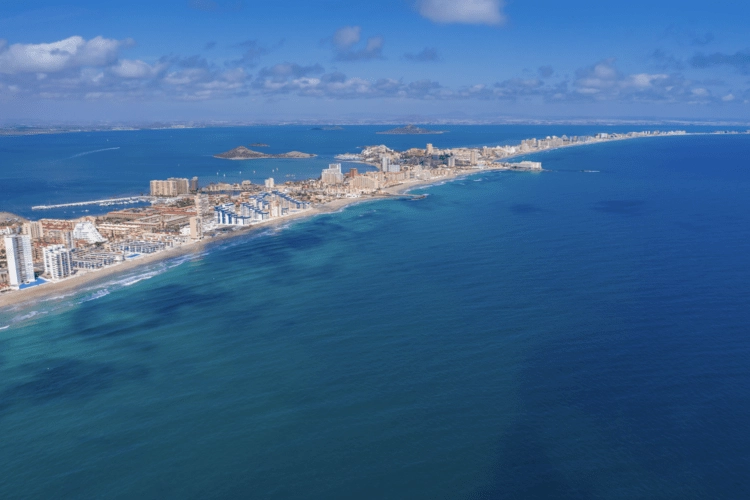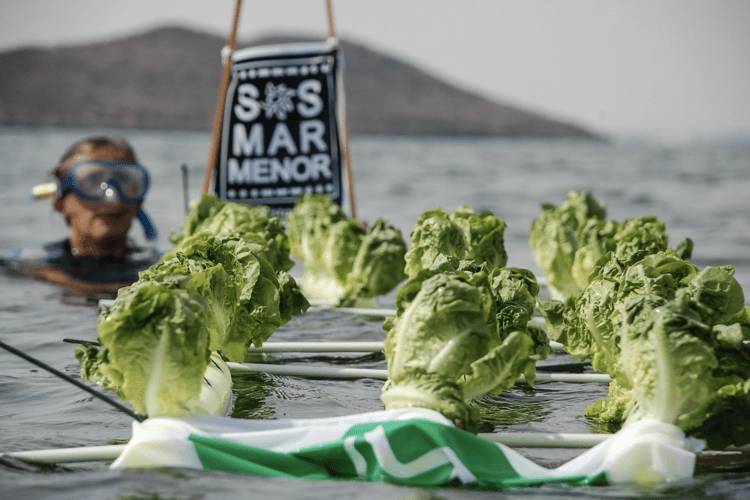
Mar Menor has long been struggling – but grassroots activists have been fighting back to protect the salt lagoon from degradation
By Marcello Rossi and Davide Mancini
In the gentle warmth of a Spring morning, Isabel Rubio strolls along Los Alcázares beach, a sandy expanse facing the Mar Menor in southeastern Spain. The sun bathes the area in a golden light and the air is tinged with the crisp scent of salt. As Rubio, a retired English teacher in her 70s, slips off her shoes and wades into the cold waters she describes how this shallow saltwater lagoon has long been a source of healing for her. But in recent years, her tired bones haven’t been her main concern as she wanders within the vast expanse of salt flats separated from the Mediterranean by a thin strip of land. It’s the health of her beloved lagoon that’s at the forefront of her mind.
Rubio and a group of concerned locals are the co-founders of Pacto por el Mar Menor, a grassroots initiative to raise awareness of the lagoon’s severe environmental decline. Together, they’ve convened public gatherings, staged protests and travelled to the European Parliament multiple times, all with one steadfast mission: saving their lagoon.

With the help of academics, marine scientists, lawyers and overwhelming local support, the campaigners have managed to secure significant victories, such as establishing legal rights for the lagoon and the creation of regulatory bodies with real teeth. However, the battle is far from over, and there have been numerous failures in this rich but fragile ecosystem in recent years.
Spanning 135 square kilometres, the Mar Menor is Europe’s largest coastal saltwater lagoon. Its warm, crystal-clear shallows and the region’s year-round temperate climate have long attracted tourists and retirees. But in recent years, this idyllic ecosystem has come under severe threat, with a number of crises pushing it to the brink of collapse.
Environmental degradation in the Mar Menor isn’t a recent phenomenon; multiple issues have afflicted the lagoon for decades. The matter first drew notice in the regional media back in 1985, when a local journalist highlighted the rapid spread of urban development in the area, and raised concerns about the possible consequences for the lagoon.
Rapid and largely unregulated agricultural intensification also occurred in the neighbouring Campo de Cartagena. Once a patchwork of small, family-run farms practising dry-land farming and catering to local markets, the area grew into an agricultural powerhouse after a new canal brought irrigation water from the Tagus – the longest river in the Iberian Peninsula – in 1979. Today, Campo de Cartagena produces more than 2.5 million tonnes of fruit and vegetables annually, much of which is exported.

The shift from traditional crops such as carob, olives and almonds to extensive monocultures of lettuce, lemons and artichokes introduced a steady flow of nitrogen and phosphorus from fertilisers, which seeped into the Mar Menor through runoff. At the same time, businesses, often with a nod from the authorities, dug wells to tap into the aquifers and set up hundreds of desalination plants to make the brackish water of the Mar Menor usable for irrigation. Many of these plants dumped nutrient-rich brine into the channels draining into the lagoon. A boom in tourism also compounded the pressure on the lagoon.
‘The Mar Menor has endured this kind of pressure for decades,’ explains Francisca Giménez Casalduero, a marine ecologist at the University of Murcia. ‘But every ecosystem has its limits, and the Mar Menor has reached its breaking point.’ The spring of 2016 saw extensive algal blooms caused by the lagoon filling up with nutrients. The algae blanketed the lagoon’s surface with sprawling mats stretching for kilometres, turning the water green and blocking sunlight from reaching the bottom. Unable to photosynthesise, most of the vegetation died. As the algae decomposed, masses of fish and crustaceans washed ashore, dead or dying from lack of oxygen.

Rubio vividly remembers the horrors of the aftermath: ‘It was the most awful sight I’ve ever seen – a disaster,’ she recalls. ‘The crabs scrambled to escape through the rocks, the shrimps piled up on top of each other, almost forming a paste, the eels leapt and the water churned as if it was boiling.’
Two more crises struck in the following years. In autumn 2019, another major die-off led to more than three tonnes of fish and crustaceans being stranded on the shores of San Pedro del Pinatar. Then, in August 2021, the lagoon experienced its most significant disaster yet, with around five tonnes of fish washing up on the shores of La Manga, the narrow sandbar that divides the Mar Menor from the Mediterranean Sea.
As the situation has worsened, blame and responsibility have become contentious issues. The local government attributed the fish deaths in the Mar Menor to natural causes such as hot weather and associated rising water temperatures. However, scientists vehemently contested these assertions, presenting compelling evidence that water quality degradation from local farming practices was the primary driver. Studies indicate that agricultural activities in the Mar Menor watershed contribute to up to 85 per cent of nutrient inputs.

The agricultural sector, which accounts for nearly ten per cent of the region’s GDP and supports 47,000 jobs, holds considerable sway over Murcia’s economy and political landscape. Over the years, close ties between governmental bodies and the farming industry have shaped policies favouring agricultural expansion and turned a blind eye to the environmental consequences. Politicians have also consistently downplayed the Mar Menor contamination, suggesting impractical remedies such as diverting large amounts of the lagoon’s water to the Mediterranean Sea.
Farmers in the area have also long baulked at shouldering the blame. ‘We are being singled out for practices of 40 or 50 years ago, when regulations were lax and authorities focused on meeting Europe’s high demand,’ insists Vicente Carrión, president of the local agricultural union, stressing that growers these days carefully use only the fertilisers they need. He also argues that pollution in the Mar Menor comes not just from farm runoff but also from an aquifer polluted by toxins from historical mining activities and urban waste.
But Julio Mas, former director of the Spanish Institute of Oceanography, dismisses the aquifer arguments as misleading. ‘The majority of nutrients entering the lagoon come from surface water streams originating in agricultural land, particularly during periods of heavy rainfall,’ he explains. ‘Only about 25 per cent of these nutrients come from the aquifer.’ Mas estimates that an average of five tonnes of nitrates have flowed into the lagoon daily until recently, totalling 4,500–5,000 tonnes annually from both surface and underground discharges.

Despite decades of scientific warnings, it’s only recently that local authorities have begun taking steps to restore and protect the Mar Menor. These measures either address the consequences of pollution, such as organising clean-ups to remove algae from the lagoon, or directly target the sources of pollution. This includes legislation, promoting the planting of hedges as natural barriers and adopting contour farming practices, cracking down on the region’s estimated 12,000 hectares of illegally irrigated land, and the creation of a 1,500-metre-wide green belt around the lagoon’s perimeter as a buffer zone.
The enforcement of these measures has posed an added financial strain on farmers, who argue they haven’t received adequate support from the authorities. Antonio Luengo, who grows peppers, celery and pumpkins on his 15-hectare farm, reckons that measures such as hedge planting cost him up to £2,500 per year, which he pays for himself. ‘I’ll stick to the rules,’ he says. ‘I’m only hoping the authorities can chip in to cover these extra costs.’
Findings from a Spanish Institute of Oceanography report suggest a recent reduction in nutrient levels. As of July 2023, about 1.7 tonnes of nitrates per day were entering the lagoon, down from previous levels that reached up to six tonnes per day. However, the report warns against viewing this stabilisation as a definitive indicator of overall ecosystem improvement. Instead, it suggests that the lagoon’s internal regulatory mechanisms and self-regulating capacity may be contributing factors to these observed changes.
Experts also err on the side of caution. ‘The water might be clear again, and people might be returning to the beach, but the sources of pollution are still there,’ says Giménez Casalduero, the University of Murcia marine biologist. ‘Acute episodes can be triggered at any time,’ she warns.

Meanwhile, the Mar Menor has become the first ecosystem in Europe to be designated with legal rights similar to those of an individual person. The notion has long been debated but has only gained traction over the past decade, during which ecosystems such as Colombia’s Atrato River and New Zealand’s Whanganui River were granted the status.
Much of the credit behind the achievement goes to Teresa Vicente, a professor of the philosophy of law at the University of Murcia. In 2019, Vicente was on a three-month fellowship at the University of Reading, in the UK, studying how other countries have legally protected natural resources, when one of her students from Murcia called up to inform her about the situation unfolding in the Mar Menor. Keen to put theory into practice, she immediately went back home.
Once there, she drafted a grassroots law and, with her team, started gathering the signatures needed to take it to parliament. To spread the word, Vicente penned an article for a local paper. She rallied support from communities along the riverbanks who were furious about the pollution right in their backyard. By 2021, Vicente had amassed more than 600,000 signatures, well beyond what was needed to present the bill. Public demonstrations, meetings with government representatives and media interviews followed until in September 2022 Spain’s senate passed it into law.
Three new regulatory bodies, consisting of government representatives, scientists and community members, have been appointed to oversee compliance. And while the lagoon may not be able to speak for itself, Vicente says any citizen is now able to file a lawsuit on behalf of Mar Menor.
She sees the initiative as a model for other European regions grappling with similar challenges. ‘This is more than just about saving a lagoon,’ she says. ‘It’s about changing how we view nature, understanding that ecosystems have their own value and rights.’
Back in Los Alcázares, Rubio remains cautiously optimistic about the future. As she looks out at the water, reflecting on all that has been lost and all that remains to be fought for, she says, ‘The lagoon’s path to recovery will be long and challenging, but we owe it to ourselves and future generations to keep pushing forward.’




